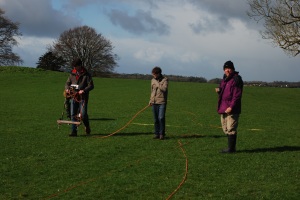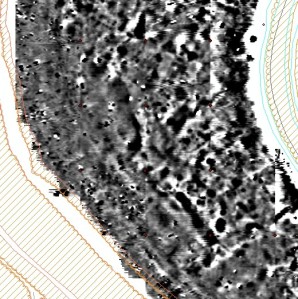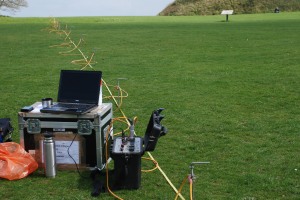‘In the castle called Seresberi’. Old Sarum and a New Survey of the Inner and Outer Baileys
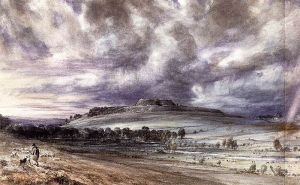
John Constable’s watercolour of Old Sarum, showing the scale of the outer ramparts and the Norman motte (source: Wikicommons, http://commons.wikimedia.org/wiki/File:John_Constable_-_Old_Sarum_-_WGA5198.jpg)
Old Sarum in Wiltshire has always proved an emotive archaeological site. The substantial ramparts of the Iron Age hillfort and the medieval motte dominate the skyline on the A345 running north from Salisbury, and has been portrayed by scholars and artists including Stukeley and John Constable. The palimpsest of settlement at the site and in its environs encompasses the Iron Age and Romano-British periods, possible Anglo-Saxon settlement, and the medieval founding of a castle, cathedral and settlement. The site formed part of the rotten borough of Old Sarum, and its strategic position was utilised during the Second World War. The Inner and then Outer Bailey formed the focus of excavations in the first part and middle of the 20th century, first by Hawly , Hope and Montgomerie in the years preceeding the First World War, then by Rahtz in the 1940s and 1950s.
The work of Hawley and Hope commenced with excavation of the Inner Bailey in the earlier seasons. Excavation then extended to the Outer Bailey, with the 1914 season focusing on the Cathedral and Bishop’s Palace. The excavation report indicates the presence of structural remains beyond those currently visible at the site, with a number of the lesser structures having been backfilled. The later work by Rahtz focused on the ramparts of the Outer Bailey and the tunnel running through the northern section of the ramparts. The body of work left from the excavations provides ample evidence of the nature and depth of the archaeological deposits for both the Inner and Outer Baileys, although the focal point of the work was always trained on the more substantial or higher status structures and buildings of the site. Much of the urban plan of the Inner Bailey, including the Palace, the Keep and Postern Tower was revealed, although some scintillating glimpses of structures from earlier periods, including a possible Roman building some 5m below the modern ground surface, were also gained. In the Outer Bailey the excavations revealed considerable structures for the cathedral and Bishop’s Palace, but much of the area in the other three quadrants of the Outer Bailey remain a mystery. On the basis of the known archaeological evidence for the site it was decided that application of topographic and geophysical survey techniques would assist in mapping the buried remains across the remainder of the Outer Bailey, and the unexcavated parts of the Inner Bailey.
To that end staff at the University of Southampton drew up a three year project overview, and were granted permission from English Heritage, to carry out a new survey at the site and in its environs as part of student fieldwork for second and third year modules in archaeological survey and geophysical survey. Results of the survey would form the basis for students to compile their own reports for assessment on the modules.
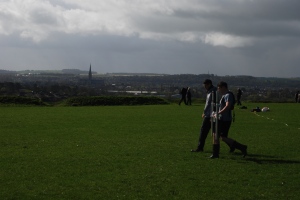
Geophysical survey in the Outer Bailey with the spire of Salisbury Cathedral visible in the background
The work of the staff and students this year centred on the area within the ramparts of the hillfort, some 6.5 hectares in size, with topographic survey and earth resistance and magnetometry being conducted in the Outer Bailey, and GPR survey across the Inner Bailey to target areas left unexcavated by Hawley and Hope. Survey was supervised by the author, Timothy Sly, Dominic Barker, Penny Copeland and Scott Chaussee.
In spite of the mixed success using magnetometry at some sites in Hampshire and Wiltshire, the nature and depth of deposits at Old Sarum meant that the flint core and stone buildings of the Outer Bailey contrast well to the surrounding sediment. In addition the response to the earth resistance survey was also clear. The preliminary results for the Outer Bailey indicate extensive structures across the entire area, with buildings spread out along the curtain wall, particularly in the south-east sector of the site, and the pattern of urban areas visible in the south-west sector.
Many of the structures from the Hawley and Hope and Rahtz excavations are also present, and new buildings are added to the plan of the north-west sector of the site, including a possible sub-circular structure.
The GPR survey in 2014 focused on the area of the Inner Bailey, utilising a 200MHz antenna, and on targetted areas in the Outer Bailey using a 500MHz antenna. In principle the use of the lower frequency antenna within the Inner Bailey should assist in locating some of the deeply buried structures below the level of medieval buildings mentioned in the literature. Potentially comparison of these results at 5-6m depth should allow a picture of the Iron Age and Roman deposits for the area to be compared with the results from the Outer Bailey.
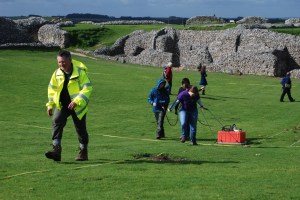
GPR survey of the Inner Bailey. Many of the excavated structures give a clear indication of the potential depth of some of the deposits, up to c.5m in places. The 200MHz antenna should allow structures to be located down to these depths
In addition to the high resolution survey work, an Electrical Resistivity Tomography (ERT) profile was run across the site, through the western entrance to the hillfort, skirting the northern side of the motte ditch, and ending close to the ramparts on the north-eastern side of the site. The profile is designed to assess the depth of archaeological sediments across the site, and their relationship to the underlying gravels and chalk.
There is much work to do for the interpretation of the results, but the correlation between the 20th century excavations and the latest results is telling. The results are allowing the team to expand on the excavation plans, showing the presence and nature of the new structures in all areas of the site, including ranges of buildings on the southern edge of the area of the Cathedral, and a substantial building standing alone in the south-eastern sector of the Outer Bailey. The plan for the next few seasons will be to complete work in the Outer Bailey, and to conduct survey in the environs of Old Sarum. The relationship between the defended site and the Roman road and settlement to the south of the ramparts will provide a focus for research.


